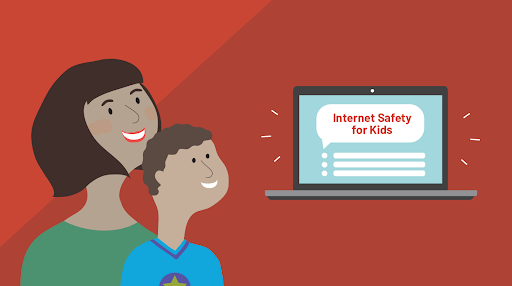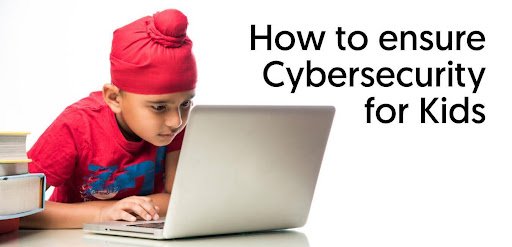Cybersecurity should be conducted through interactive simulations, real-world examples, and hands-on exercises. By emphasising strong password practices, recognising scam attempts, and securing personal information. Here, we promote a culture of care and responsible online behaviour. Hence, provides ongoing updates on emerging threats, encourages open communication about digital security, and empowers learners with essential skills for a safer online experience.
Introduction to Cybersecurity for Kids

Hey kids! Cybersecurity is like a superhero shield for your online experiences. It’s all about staying safe and smart on the internet. Imagine your password is your secret superhero code keep it strong and don’t share it. Avoid clicking on strange links they might be traps set by online villains. Always update your gadgets and apps it’s like upgrading your superhero gear. Be a wise explorer and only share information with trusted friends. If something feels fishy, tell a grown-up superhero. Remember, with cybersecurity, you are the hero of your digital world, protecting it from virtual bad guys. Stay safe and have fun online.
Cybersecurity is like your very own superhero cape, protecting you from digital dangers. Let’s start with the basics: online safety. Imagine your computer, tablet, or phone as your spaceship, and the internet as the vast universe waiting to be explored. Here are a few simple rules to navigate this cosmic adventure:
- Secret Identity: Your passwords are like secret codes. Keep them safe and don’t share them with anyone, not even your best friends. This helps protect your personal information.
- Stranger Danger: Just like you wouldn’t talk to strangers in the park, be cautious online. Only chat with people you know in real life, like classmates, friends, and family.
- Updates and Upgrades: Your spaceship needs regular check-ups to stay strong. Similarly, update your devices and apps regularly. These updates fix bugs and add extra shields to keep you safe.
- Virus Villains: Beware of viruses. These digital bad guys can harm your spaceship. Install antivirus software to keep them at bay.
- Cyberbully Blocker: If someone is being mean online, don’t hesitate to tell a trusted adult. They can help and make sure your online space remains friendly.
- Privacy Forcefield: Set your privacy settings to control who can see your information. It’s like having a forcefield around your spaceship, keeping your secrets safe.
- Log Out Landing: Always log out when you are done exploring. It’s like parking your spaceship safely before heading back to the real world.
The Role of Parents and Educators

Parents and educators play a key role in guiding children through the complexity of the digital world. In this rapidly evolving technological era, it is crucial for parents to engage in their children’s digital lives actively. Like, open communication, establishing boundaries, and setting a positive example are essential. The educators, too, must integrate digital literacy into the curriculum, teaching students to guide online spaces responsibly. Together, parents and educators should promote critical thinking skills, emphasising the importance of understanding when consuming digital content. Monitoring screen time, discussing online safety, and addressing cyberbullying are also vital aspects. Collaboration between parents and educators is key to promoting a generation that is not only proficient in technology but also equipped with the values and skills necessary to navigate the digital landscape responsibly.
Common Online Threats for Children
Children face various online threats that parents should be aware of to ensure their safety. Cyberbullying is a common danger, where kids experience harassment or shame online. Predators may use their innocence, posing as friends to gain trust. Inappropriate content direction is another risk, as children might struggle with unsuitable material.
To reduce these threats, parents should actively engage with their kids, encouraging open communication about online activities. Monitoring online interactions without overstepping on privacy helps ensure a safe digital environment. Educating children on responsible internet use and the importance of reporting any uncomfortable situations empowers them to navigate the online world securely. Implementing parental controls and setting age-appropriate content restrictions also adds an extra layer of protection. By staying educated and involved, parents can help safeguard their children from potential online dangers.
Interactive Learning Tools for Cybersecurity
Engaging kids in cybersecurity education can be achieved through interactive learning tools, such as games and apps. These tools make the complex subject enjoyable and accessible for young minds. Interactive games teach cybersecurity concepts, like online safety and threat awareness, in a fun and engaging manner. Apps provide hands-on experiences, allowing kids to explore the digital world while learning essential skills.
These educational tools often incorporate age-appropriate challenges and scenarios, promoting critical thinking and problem-solving skills. By gamifying cybersecurity, children can learn the importance of protecting personal information and understanding potential online risks. The interactive character of these tools ensures that learning is dynamic and memorable.
Parents and educators can hold these resources to create a positive and interactive learning environment, investing in cybersecurity awareness from an early age. As technology advances, these tools play a crucial role in preparing the next generation to navigate the digital landscape safely and responsibly.
Teaching Password Safety and Privacy
Protect your personal information with these fundamental tips.
- Create strong passwords using a mix of letters, numbers, and symbols, and avoid easily guessable information like birthdays.
- Use unique passwords for each account to minimise risks.
- For an additional layer of security, use two-factor identification wherever it is possible.
- Regularly update passwords and avoid saving them in easily accessible places.
- Be cautious of scams by verifying the authenticity of emails and links.
- Limit the information you share online, especially on social media.
- Keep software and antivirus programs up-to-date to safeguard against vulnerabilities.
- Educate yourself and others on the importance of privacy to ensure a safer digital experience.
The Importance of Digital Etiquette
Digital etiquette is important for promoting respectful online interactions. In the digital age, where communication happens through screens, it’s essential to uphold polite behaviour. Respecting others’ opinions, withholding offensive language, and avoiding cyberbullying are fundamental aspects of digital etiquette. Thoughtful communication enhances online communities, promoting a positive and inclusive environment. A clear and brief expression of ideas helps avoid misunderstandings, fostering healthy discussions.
Additionally, respecting privacy by refraining from sharing sensitive information without consent builds trust. In the virtual realm, where words can be misconstrued, being mindful of tone and context prevents forced conflicts. Ultimately, practising digital etiquette ensures a pleasant online space where individuals can connect, share ideas, and collaborate respectfully.
Dealing with Cyberbullying
Preventing cyberbullying requires a multi-faceted approach. Education plays a crucial role in promoting digital literacy and responsible online behaviour, which helps individuals recognize and avoid harmful situations. Encouraging open communication between parents, educators, and students fosters a supportive environment.
Potential criminals are discouraged by choosing clear guidelines for online behaviour and values around cyberbullying. Schools should implement comprehensive anti-bullying policies that include cyberbullying, ensuring a safe online space. Emphasising empathy and kindness in curricula cultivates a positive online culture.
Supportive responses involve taking reports seriously and conducting thorough investigations. Encourage victims to seek help and reassure them that they are not alone. Implementing counselling services and mental health support can address the emotional toll of cyberbullying.
Promoting a culture of reporting and intervention empowers bystanders to speak up against cyberbullying. Collaboration between schools, parents, and online platforms helps create a united front against this pervasive issue. By combining prevention strategies and compassionate responses, we can work towards a safer digital space for everyone.
Safe Social Media Usage for Kids

Ensure your child’s safe social media usage with these guidelines.
- Firstly, set age-appropriate platforms and privacy settings.
- Teach them to share minimal personal information, like school or address.
- Encourage using strong, unique passwords and explain the importance of not sharing them.
- Emphasise the significance of treating others with respect online and reporting any inappropriate behaviour.
- Regularly monitor your child’s online activity without invading their privacy.
- Promote open communication so they feel comfortable discussing concerns or experiences.
- Educate them on the permanence of digital content and the potential consequences of sharing inappropriate or sensitive material.
- Lastly, it instills a healthy balance between online and offline activities, promoting well-rounded development.
By following these simple steps, you can help create a secure online environment for your child.
Staying Updated with Cybersecurity Trends
In today’s rapidly evolving digital landscape, staying updated on cybersecurity trends is important to safeguard against new and emerging online threats. Regularly monitoring industry developments, attending cybersecurity conferences, and following reputable digital blogs are essential practices. Keep up-to-date on the latest attack techniques, vulnerabilities, and protective measures to ready digital defences. Engage in continuous learning through online courses and certifications to enhance expertise. Collaborate with cybersecurity communities to share insights and strategies. Prioritise implementing robust security protocols, employing cutting-edge tools, and conducting regular risk assessments. As threats evolve, bold adaptation to innovative security measures becomes crucial. By promoting a culture of vigilance and knowledge-sharing, individuals and organisations can effectively prepare for and mitigate the challenges posed by cybersecurity threats.
Conclusion: Building a Secure Digital Future
In conclusion, enabling a secure digital future requires a concerted effort to empower the next generation of internet users. By prioritising cybersecurity education, instilling digital literacy, and developing robust online safety measures, we can create an environment where users, particularly the younger generation, navigate the internet with confidence and resilience. Joint initiatives between governments, tech industries, and educational institutions are essential to address emerging threats and promote responsible online behaviour. As we advance into an increasingly interconnected world, a bold approach to cybersecurity is paramount, ensuring that individuals are equipped with the knowledge and skills to protect themselves and contribute to a safer digital landscape. Together, we can build a secure foundation for the future, where innovation and connectivity thrive in harmony with user safety and privacy.
For more educational resources and insights into child development, visit Chrysalis High.


